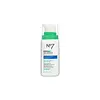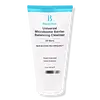What's inside
What's inside
 Key Ingredients
Key Ingredients

 Benefits
Benefits

 Concerns
Concerns

 Ingredients Side-by-side
Ingredients Side-by-side

Water
Skin ConditioningDicaprylyl Carbonate
EmollientGlycerin
HumectantAnnona Cherimola Fruit Extract
Skin ConditioningSaccharide Isomerate
HumectantNiacinamide
SmoothingPropanediol
SolventPanthenol
Skin ConditioningSodium Polyacrylate
AbsorbentTrifolium Pratense Flower Extract
AstringentAcrylates/C10-30 Alkyl Acrylate Crosspolymer
Emulsion StabilisingPhenoxyethanol
PreservativeButylene Glycol
HumectantPolysorbate 20
EmulsifyingSodium Hyaluronate
HumectantCaprylyl Glycol
EmollientSodium Benzoate
MaskingSodium Lauroyl Lactylate
EmulsifyingBisabolol
MaskingSodium Citrate
BufferingEthylhexylglycerin
Skin ConditioningTetrasodium EDTA
Panax Ginseng Root Extract
EmollientCitric Acid
BufferingLecithin
EmollientCeramide NP
Skin ConditioningBiphenyl Azepanyl Methanone
Skin ConditioningPhenylpropanol
MaskingSodium Dehydroacetate
PreservativeCeramide AP
Skin ConditioningPhytosphingosine
Skin ConditioningCholesterol
EmollientCarbomer
Emulsion StabilisingXanthan Gum
EmulsifyingTocopherol
AntioxidantBiotin
AntiseborrhoeicCeramide EOP
Skin ConditioningWater, Dicaprylyl Carbonate, Glycerin, Annona Cherimola Fruit Extract, Saccharide Isomerate, Niacinamide, Propanediol, Panthenol, Sodium Polyacrylate, Trifolium Pratense Flower Extract, Acrylates/C10-30 Alkyl Acrylate Crosspolymer, Phenoxyethanol, Butylene Glycol, Polysorbate 20, Sodium Hyaluronate, Caprylyl Glycol, Sodium Benzoate, Sodium Lauroyl Lactylate, Bisabolol, Sodium Citrate, Ethylhexylglycerin, Tetrasodium EDTA, Panax Ginseng Root Extract, Citric Acid, Lecithin, Ceramide NP, Biphenyl Azepanyl Methanone, Phenylpropanol, Sodium Dehydroacetate, Ceramide AP, Phytosphingosine, Cholesterol, Carbomer, Xanthan Gum, Tocopherol, Biotin, Ceramide EOP
Water
Skin ConditioningStearic Acid
CleansingGlycerin
HumectantPropanediol
SolventPotassium Hydroxide
BufferingMyristic Acid
CleansingCocamidopropyl Hydroxysultaine
CleansingCI 77163
Cosmetic ColorantCarbomer
Emulsion StabilisingSodium Cocoyl Isethionate
CleansingEthylhexyl Hydroxystearate
EmollientSucrose
HumectantSilver
Cosmetic ColorantPunica Granatum Sterols
Skin ConditioningCocos Nucifera Oil
MaskingLinoleic Acid
CleansingSqualane
EmollientCaffeine
Skin ConditioningCocos Nucifera Fruit Juice
EmollientCocos Nucifera Water
MaskingAmaranthus Caudatus Seed Oil
EmollientHordeum Vulgare Extract
EmollientTriticum Vulgare Germ Extract
Skin ConditioningSodium Hyaluronate
HumectantMica
Cosmetic ColorantCoconut Alkanes
EmollientCoco-Caprylate/Caprate
EmollientSodium Chloride
MaskingDicaprylyl Ether
EmollientCI 77891
Cosmetic ColorantCalcium Aluminum Borosilicate
Polyquaternium-39
Lecithin
EmollientSodium Benzoate
MaskingTin Oxide
AbrasiveCI 77510
Cosmetic ColorantWater, Stearic Acid, Glycerin, Propanediol, Potassium Hydroxide, Myristic Acid, Cocamidopropyl Hydroxysultaine, CI 77163, Carbomer, Sodium Cocoyl Isethionate, Ethylhexyl Hydroxystearate, Sucrose, Silver, Punica Granatum Sterols, Cocos Nucifera Oil, Linoleic Acid, Squalane, Caffeine, Cocos Nucifera Fruit Juice, Cocos Nucifera Water, Amaranthus Caudatus Seed Oil, Hordeum Vulgare Extract, Triticum Vulgare Germ Extract, Sodium Hyaluronate, Mica, Coconut Alkanes, Coco-Caprylate/Caprate, Sodium Chloride, Dicaprylyl Ether, CI 77891, Calcium Aluminum Borosilicate, Polyquaternium-39, Lecithin, Sodium Benzoate, Tin Oxide, CI 77510
 Reviews
Reviews

Ingredients Explained
These ingredients are found in both products.
Ingredients higher up in an ingredient list are typically present in a larger amount.
Carbomer is a polymer of acrylic acid. Its main role is to create a gel consistency.
A high amount of carbomer can cause pilling or balling up of products. Don't worry, most products contain 1% or less of carbomer.
Glycerin is already naturally found in your skin. It helps moisturize and protect your skin.
A study from 2016 found glycerin to be more effective as a humectant than AHAs and hyaluronic acid.
As a humectant, it helps the skin stay hydrated by pulling moisture to your skin. The low molecular weight of glycerin allows it to pull moisture into the deeper layers of your skin.
Hydrated skin improves your skin barrier; Your skin barrier helps protect against irritants and bacteria.
Glycerin has also been found to have antimicrobial and antiviral properties. Due to these properties, glycerin is often used in wound and burn treatments.
In cosmetics, glycerin is usually derived from plants such as soybean or palm. However, it can also be sourced from animals, such as tallow or animal fat.
This ingredient is organic, colorless, odorless, and non-toxic.
Glycerin is the name for this ingredient in American English. British English uses Glycerol/Glycerine.
Learn more about GlycerinLecithin is a term for a group of substances found in the cell membranes of plants, animals, and humans. They are made up of mixture of phospholipids.
This ingredient has emollient and emulsifying properties.
As an emollient, lecithen helps soften the skin and creates a barrier to keep moisture in.
As an emulsifier, it also helps prevent water and oil ingredients from separating. Lecithin can also help ingredients be better absorbed by the skin.
This is because the phospholipids in lecithin produce liposomes. Liposomes help other ingredients get through the skin barrier.
Depending on the source of this ingredient, lecithin may not be fungal acne safe. This is because some sources of lecithin come from soybean oil, which may feed the malassezia yeast that feeds fungal acne.
We recommend reaching out to the brand you are purchasing from to inquire about the source of their lecithin.
Some other names for this ingredient include soy lecithin and deoiled soy lecithin.
Learn more about LecithinPropanediol is an all-star ingredient. It softens, hydrates, and smooths the skin.
It’s often used to:
Propanediol is not likely to cause sensitivity and considered safe to use. It is derived from corn or petroleum with a clear color and no scent.
Learn more about PropanediolSodium Benzoate is a preservative. It's used in both cosmetic and food products to inhibit the growth of mold and bacteria. It is typically produced synthetically.
Both the US FDA and EU Health Committee have approved the use of sodium benzoate. In the US, levels of 0.1% (of the total product) are allowed.
Sodium benzoate works as a preservative by inhibiting the growth of bacteria inside of cells. It prevents the cell from fermenting a type of sugar using an enzyme called phosphofructokinase.
It is the salt of benzoic acid. Foods containing sodium benzoate include soda, salad dressings, condiments, fruit juices, wines, and snack foods.
Studies for using ascorbic acid and sodium benzoate in cosmetics are lacking, especially in skincare routines with multiple steps.
We always recommend speaking with a professional, such as a dermatologist, if you have any concerns.
Learn more about Sodium BenzoateSodium Hyaluronate is hyaluronic acid's salt form. It is commonly derived from the sodium salt of hyaluronic acid.
Like hyaluronic acid, it is great at holding water and acts as a humectant. This makes it a great skin hydrating ingredient.
Sodium Hyaluronate is naturally occurring in our bodies and is mostly found in eye fluid and joints.
These are some other common types of Hyaluronic Acid:
Learn more about Sodium HyaluronateWater. It's the most common cosmetic ingredient of all. You'll usually see it at the top of ingredient lists, meaning that it makes up the largest part of the product.
So why is it so popular? Water most often acts as a solvent - this means that it helps dissolve other ingredients into the formulation.
You'll also recognize water as that liquid we all need to stay alive. If you see this, drink a glass of water. Stay hydrated!
Learn more about Water